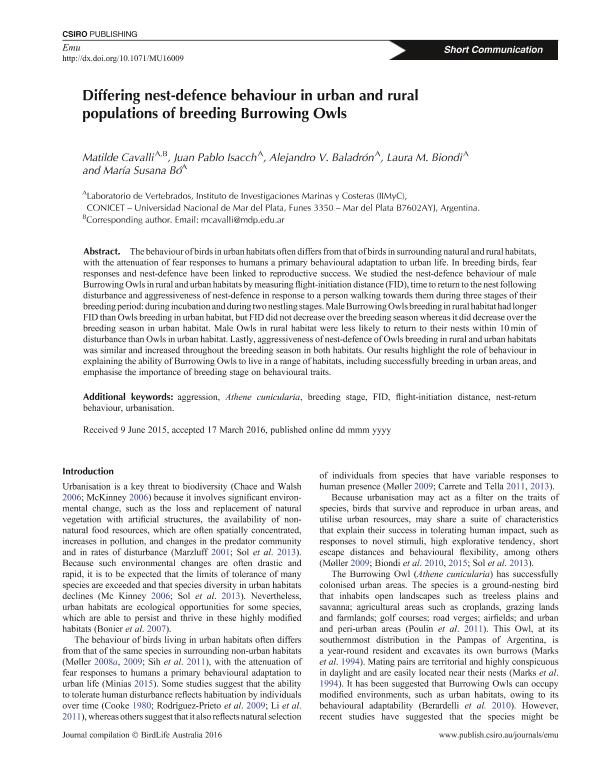Artículo
Differing nest-defence behaviour in urban and rural populations of breeding Burrowing Owls
Cavalli, Matilde ; Isacch, Juan Pablo
; Isacch, Juan Pablo ; Baladron Felix, Alejandro Victor
; Baladron Felix, Alejandro Victor ; Biondi, Laura Marina
; Biondi, Laura Marina ; Bó, Maria Susana
; Bó, Maria Susana
 ; Isacch, Juan Pablo
; Isacch, Juan Pablo ; Baladron Felix, Alejandro Victor
; Baladron Felix, Alejandro Victor ; Biondi, Laura Marina
; Biondi, Laura Marina ; Bó, Maria Susana
; Bó, Maria Susana
Fecha de publicación:
04/2016
Editorial:
Csiro Publishing
Revista:
Emu
ISSN:
0158-4197
Idioma:
Inglés
Tipo de recurso:
Artículo publicado
Clasificación temática:
Resumen
The behaviour of birds in urban habitats often differs from that of birds in surrounding natural and rural habitats, with the attenuation of fear responses to humans a primary behavioural adaptation to urban life. In breeding birds, fear responses and nest-defence have been linked to reproductive success. We studied the nest-defence behaviour of male Burrowing Owls in rural and urban habitats by measuring flight-initiation distance (FID), time to return to the nest following disturbance and aggressiveness of nest-defence in response to a person walking towards them during three stages of their breeding period: during incubation and during two nestling stages. Male Burrowing Owls breeding in rural habitat had longer FID than Owls breeding in urban habitat, but FID did not decrease over the breeding season whereas it did decrease over the breeding season in urban habitat. Male Owls in rural habitat were less likely to return to their nests within 10min of disturbance than Owls in urban habitat. Lastly, aggressiveness of nest-defence of Owls breeding in rural and urban habitats was similar and increased throughout the breeding season in both habitats. Our results highlight the role of behaviour in explaining the ability of Burrowing Owls to live in a range of habitats, including successfully breeding in urban areas, and emphasise the importance of breeding stage on behavioural traits.
Archivos asociados
Licencia
Identificadores
Colecciones
Articulos(CCT - MAR DEL PLATA)
Articulos de CTRO.CIENTIFICO TECNOL.CONICET - MAR DEL PLATA
Articulos de CTRO.CIENTIFICO TECNOL.CONICET - MAR DEL PLATA
Articulos(IIMYC)
Articulos de INSTITUTO DE INVESTIGACIONES MARINAS Y COSTERAS
Articulos de INSTITUTO DE INVESTIGACIONES MARINAS Y COSTERAS
Citación
Cavalli, Matilde; Isacch, Juan Pablo; Baladron Felix, Alejandro Victor; Biondi, Laura Marina; Bó, Maria Susana; Differing nest-defence behaviour in urban and rural populations of breeding Burrowing Owls; Csiro Publishing; Emu; 116; 4; 4-2016; 428-434
Compartir
Altmétricas



